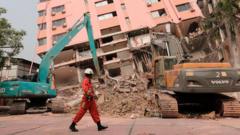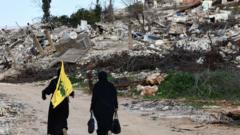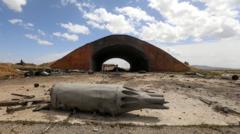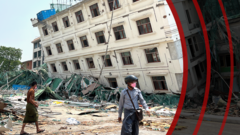The Organization for the Prohibition of Chemical Weapons has identified over 100 potential sites linked to chemical weapons in Syria, raising fears about unsecured stockpiles of deadly agents.**
Emerging Concerns Over Chemical Weapons Sites in Post-Assad Syria**

Emerging Concerns Over Chemical Weapons Sites in Post-Assad Syria**
More than 100 suspected chemical weapons sites pose a significant challenge for the new government in Syria, as international scrutiny mounts.**
The aftermath of Syria's civil war continues to pose complex challenges, especially regarding the remnants of the previous regime's weapons programs. Recent estimates reveal that more than 100 chemical weapons sites are believed to still exist in Syria, a startling figure released by the Organization for the Prohibition of Chemical Weapons (OPCW). This assessment comes as the new government, led by Hayat Tahrir al-Sham, strives to establish control in the post-Bashar al-Assad era.
The OPCW's report highlights that these sites were reportedly involved in the research, manufacturing, and storage of chemical weapons, including the infamous nerve agent sarin and chlorine gas, which Assad's regime utilized against both rebel forces and civilians during the prolonged conflict. With the regime toppled, the safety and security of these sites remain obscure, raising alarms about potential dangers to the population in a region still grappling with instability.
The concerning volume of chemical weapons stockpiles poses a formidable test for the current leadership. Hayat Tahrir al-Sham, although designated as a terrorist organization by the United States, claims to have severed ties with Al Qaeda. The group is now tasked with managing this sensitive issue while upholding public safety amidst a backdrop of political and social upheaval.
Experts warn of the catastrophic implications if these substances remain unsecured. Historical records of chemical warfare illustrate the devastating effects such agents can inflict, with sarin having the capacity to kill within minutes and chlorine gas causing excruciating injuries through asphyxiation.
As international bodies and local authorities focus their efforts on addressing these threats, the quest for security and peace in Syria continues to be complicated by the legacy of chemical warfare left in the wake of a brutal regime. The coming months will be crucial in determining how effectively the new government can mitigate these risks and ensure the safety of its citizens.
The OPCW's report highlights that these sites were reportedly involved in the research, manufacturing, and storage of chemical weapons, including the infamous nerve agent sarin and chlorine gas, which Assad's regime utilized against both rebel forces and civilians during the prolonged conflict. With the regime toppled, the safety and security of these sites remain obscure, raising alarms about potential dangers to the population in a region still grappling with instability.
The concerning volume of chemical weapons stockpiles poses a formidable test for the current leadership. Hayat Tahrir al-Sham, although designated as a terrorist organization by the United States, claims to have severed ties with Al Qaeda. The group is now tasked with managing this sensitive issue while upholding public safety amidst a backdrop of political and social upheaval.
Experts warn of the catastrophic implications if these substances remain unsecured. Historical records of chemical warfare illustrate the devastating effects such agents can inflict, with sarin having the capacity to kill within minutes and chlorine gas causing excruciating injuries through asphyxiation.
As international bodies and local authorities focus their efforts on addressing these threats, the quest for security and peace in Syria continues to be complicated by the legacy of chemical warfare left in the wake of a brutal regime. The coming months will be crucial in determining how effectively the new government can mitigate these risks and ensure the safety of its citizens.


















